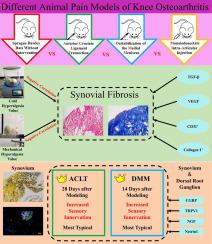Journal of Advanced Research ( IF 11.4 ) Pub Date : 2021-06-15 , DOI: 10.1016/j.jare.2021.06.007 Li Zhang 1, 2, 3 , Mingchao Li 1, 3 , Xiaochen Li 1, 2, 3 , Taiyang Liao 1, 2, 3 , Zhenyuan Ma 1, 2, 3 , Li Zhang 1, 2 , Runlin Xing 1, 2 , Peimin Wang 1, 2 , Jun Mao 1, 2

|
Introduction
Knee osteoarthritis (KOA) showed synovial fibrosis and hyperalgesia, although the correlation between the two is unclear. Besides, the specific changes of sensory innervation in animal models are still controversial, which makes it difficult to choose the modeling methods for KOA pain research.
Objectives
Study the characteristics of sensory innervation within three commonly used KOA rat models and the correlation between synovial fibrosis and hyperalgesia.
Methods
KOA models were induced by destabilization of medial meniscus (DMM), anterior cruciate ligament transection (ACLT), and monoiodoacetate (MIA), respectively. Mechanical, cold and thermal withdrawal threshold (MWT, CWT and TWT) were measured. The harvested tissues were used for pathological sections, immunofluorescence and quantitative analysis.
Results
KOA synovium showed more type I collagen deposition, increased expression of CD31, VEGF and TGF-β. These changes were most pronounced in surgical models, with DMM presenting the most prominent at Day 14 and ACLT at Day 28. Day 14, changes in mechanical hyperalgesia and cold hyperalgesia were most typical in DMM model and statistically different from MIA. There was a negative correlation between the percentage of type I collagen and MWT value (r = −0.88), as well as CWT value (r = −0.95). DMM synovium showed more axonal staining, upregulated CGRP, TRPV1, NGF and Netrin1 compared with MIA. Above changes were also observed at Day 28, but ACLT replaced DMM as the most typical. In DRG, only the levels of CGRP and NGF were different among KOA models at Day 14, and the highest in DMM, which was statistically different compared with MIA.
Conclusions
This study described the details of sensory innervation in different KOA model of rats, and the degree of synovial fibrosis was positively correlated with the pain sensitivity of KOA model rats. Additionally, surgical modeling especially ACLT method is more recommended for KOA pain research.
中文翻译:

不同膝骨关节炎模型大鼠滑膜感觉神经支配特征及滑膜纤维化与痛觉过敏的相关性
介绍
膝骨关节炎 (KOA) 显示滑膜纤维化和痛觉过敏,尽管两者之间的相关性尚不清楚。此外,动物模型中感觉神经支配的具体变化仍存在争议,这使得KOA疼痛研究的建模方法难以选择。
目标
研究三种常用KOA大鼠模型的感觉神经支配特征以及滑膜纤维化与痛觉过敏的相关性。
方法
KOA 模型分别由内侧半月板 (DMM)、前交叉韧带横断 (ACLT) 和单碘乙酸 (MIA) 的不稳定诱导。测量了机械、冷和热撤回阈值(MWT、CWT 和 TWT)。采集的组织用于病理切片、免疫荧光和定量分析。
结果
KOA滑膜显示更多的I型胶原沉积,CD31、VEGF和TGF-β的表达增加。这些变化在手术模型中最为明显,DMM 在第 14 天表现最为突出,ACLT 在第 28 天表现最为突出。第 14 天,机械痛觉过敏和冷痛觉过敏的变化在 DMM 模型中最为典型,并且与 MIA 有统计学差异。I型胶原百分比与MWT值(r = -0.88)以及CWT值(r = -0.95)之间存在负相关。与 MIA 相比,DMM 滑膜显示出更多的轴突染色,上调 CGRP、TRPV1、NGF 和 Netrin1。在第 28 天也观察到上述变化,但 ACLT 取代 DMM 成为最典型的。在DRG中,仅在第14天KOA模型中CGRP和NGF的水平不同,并且在DMM中最高,与MIA相比具有统计学差异。
结论
本研究描述了不同KOA模型大鼠感觉神经支配的细节,滑膜纤维化程度与KOA模型大鼠的疼痛敏感性呈正相关。此外,手术建模,尤其是 ACLT 方法更推荐用于 KOA 疼痛研究。











































 京公网安备 11010802027423号
京公网安备 11010802027423号